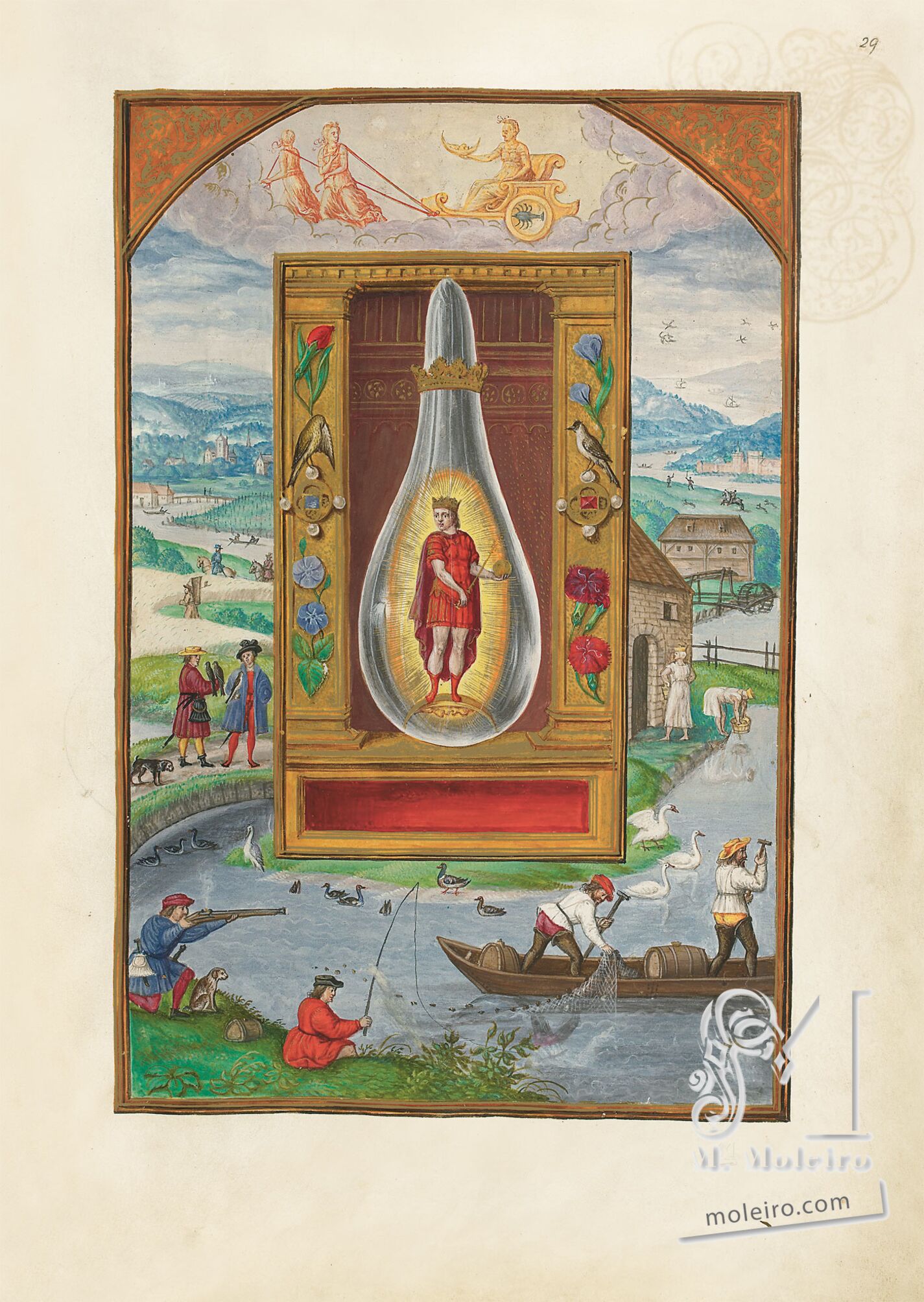The eighteenth miniature in the Splendor Solis, which is also the seventh and last in the planet series, features the planetary goddess Luna. Seated in a golden, single-axle chariot, which is drawn by two maidens in red and gold, she holds out her attribute, a large crescent-moon face, concave side up. On the ground below is an idyllic, almost Arcadian scene where the children of the moon live in harmony with nature, having subjugated it to their will.
Another large crescent-moon face can be found at the bottom of the flask inside the niche at the centre of the interior miniature. With its convex side up, the crescent moon serves as a semi-circular pedestal for the young king clad in two different shades of red. The pictured combination of a short crimson tunic and boots of the same colour with a purple cloak is extremely subtle. Although it is unusual by today’s standards, this colour combination is redolent of the style of the Gothic period. Mainly familiar to us from the works of Rogier van der Weyden and Hugo van der Goes, the concomitance of the two reds as a sign of superior character can also be seen in the works of Albrecht Dürer and his contemporaries. Their exquisiteness makes them fitting colours for the young monarch who, depicted within a radiant golden aura, bears the golden insignia of his dominion: a sceptre in his right hand, an apple in his left hand and a crown upon his head.
Representing the highest level of alchemical transmutation, this miniature has an unmistakably idyllic, or perhaps even paradisiacal, air about it. The promise of a Golden Age is reflected in the miniature’s composition of light and opulent use of gold. It is a promise further heightened by the time-bound gentility of the two combined shades of red, also mentioned by the inscription in the colour cartouche of the Nuremberg manuscript: “Jam mors consumata et filius noster regnat rubram (...) toga’ et chermes indutus est” (Death has already been overcome and our son reigns, clad in a red toga and crimson). The motif of the red king in the vas hermeticum relates to the preceding illustration of the white queen in the flask, both images referencing a miniature in the Donum Dei. The eponymous colour red also stands for the alchemical phase of rubedo which is associated with the production of gold.
Jörg Völlnagel
(Art historian, research associate at the Staatliche Museen zu Berlin)

The eighteenth miniature in the Splendor Solis, which is also the seventh and last in the planet series, features the planetary goddess Luna. Seated in a golden, single-axle chariot, which is drawn by two maidens in red and gold, she holds out her attribute, a large crescent-moon face, concave side up. On the ground below is an idyllic, almost Arcadian scene where the children of the moon live in harmony with nature, having subjugated it to their will.
Another large crescent-moon face can be found at the bottom of the flask inside the niche at the centre of the interior miniature. With its convex side up, the crescent moon serves as a semi-circular pedestal for the young king clad in two different shades of red. The pictured combination of a short crimson tunic and boots of the same colour with a purple cloak is extremely subtle. Although it is unusual by today’s standards, this colour combination is redolent of the style of the Gothic period. Mainly familiar to us from the works of Rogier van der Weyden and Hugo van der Goes, the concomitance of the two reds as a sign of superior character can also be seen in the works of Albrecht Dürer and his contemporaries. Their exquisiteness makes them fitting colours for the young monarch who, depicted within a radiant golden aura, bears the golden insignia of his dominion: a sceptre in his right hand, an apple in his left hand and a crown upon his head.
Representing the highest level of alchemical transmutation, this miniature has an unmistakably idyllic, or perhaps even paradisiacal, air about it. The promise of a Golden Age is reflected in the miniature’s composition of light and opulent use of gold. It is a promise further heightened by the time-bound gentility of the two combined shades of red, also mentioned by the inscription in the colour cartouche of the Nuremberg manuscript: “Jam mors consumata et filius noster regnat rubram (...) toga’ et chermes indutus est” (Death has already been overcome and our son reigns, clad in a red toga and crimson). The motif of the red king in the vas hermeticum relates to the preceding illustration of the white queen in the flask, both images referencing a miniature in the Donum Dei. The eponymous colour red also stands for the alchemical phase of rubedo which is associated with the production of gold.
Jörg Völlnagel
(Art historian, research associate at the Staatliche Museen zu Berlin)